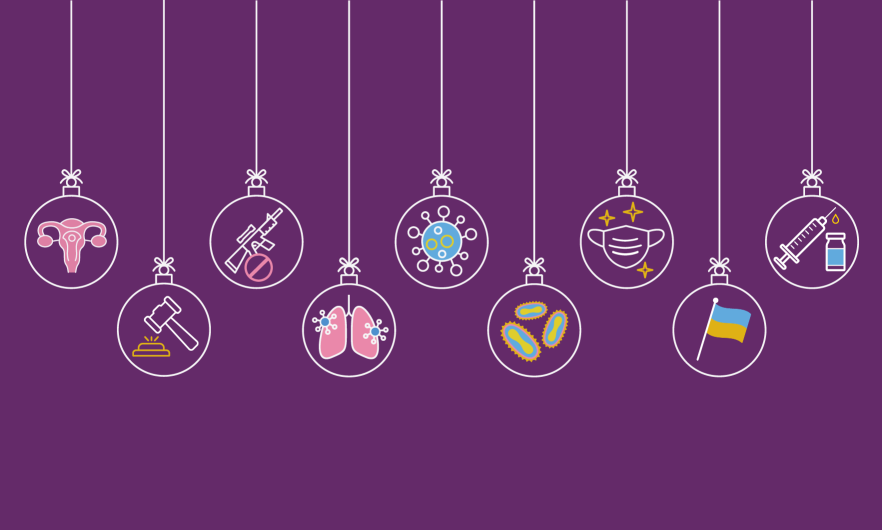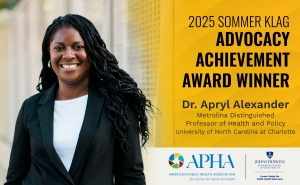Public Health in 2022: A Year of Adversities and Accomplishments
Looking back at some of the biggest public health headlines of 2022.

It’s been an eventful year, full of ups and downs, and not just in terms of COVID-19 case counts. The events outlined below are just a few of the numerous public health struggles and successes felt around the world. From environmental and humanitarian crises to legislative wins and losses, the Public Health On Call podcast brought you expert perspectives to unpack the year’s most important stories—and to highlight the critical role public health workers play in promoting and protecting the welfare of communities everywhere.
Viral Outbreaks
In May, cases of mpox (formerly “monkeypox”) were documented around the world, beyond countries where the virus is endemic. In July, the WHO declared the ongoing outbreak a Public Health Emergency of International Concern. Vaccines were prioritized for at-risk populations, and mpox cases in the U.S. have fallen steadily after peaking in August.
In February, a confirmed case of wild polio in Malawi, later linked to five cases in Mozambique through August, was met with a swift, comprehensive response. Also in August, the first case of paralytic polio in the U.S. in decades was reported, bringing renewed attention to the importance of global vaccine coverage to prevent further outbreaks.
We exit 2022 amid a “tripledemic” of flu, COVID, and RSV cases. Experts continue to remind the public that the same mitigation measures we’ve used for COVID also work to limit transmission of flu and RSV.
Attacks on Health Care
In its almost yearlong invasion of Ukraine, Russia has repeatedly targeted hospitals, ambulances, and first responders, attacks that constitute war crimes. As of November, the WHO verified at least 703 attacks on health care facilities in Ukraine since the war began.
Gun Violence
On May 24, an 18-year-old used an AR-style rifle to kill 19 students and 2 teachers and wound 17 others at Robb Elementary School in Uvalde, Texas. It was the deadliest school shooting ever in Texas and the third deadliest school shooting in U.S. history.
A month later, the U.S. Supreme Court’s ruling on New York State Rifle & Pistol Association v. Bruen removed some restrictions for concealed carry of firearms in the state and subsequently led several other states to relax their concealed carry laws. The decision also changed the way future gun cases must be evaluated by lower courts.
On a brighter note, 2022 also saw Congress pass the most significant federal gun violence prevention law in nearly 30 years, one that addresses several key areas that research shows can lead to meaningful reductions in gun violence. And in the midterms, Oregon voters passed Measure 114, which puts permit-to-purchase laws in place and restricts magazine capacity on firearms.
Reproductive Rights
In June, the Supreme Court issued a decision in Dobbs v. Jackson Women's Health Organization, overturning the constitutional right to abortion and returning regulation of reproductive rights to individual states. The ruling’s short-term effects have already been felt across the country, from the trigger laws that went into effect as soon as Roe was overturned, to the ongoing confusion and fear experienced by health care professionals and people who are or could become pregnant. The long-term impacts, both domestically and around the world, will continue to play out over the years to come.
On the flip side, the 2022 midterms also saw encouraging news from several states in which voters chose to enshrine abortion protections in their state constitutions and reject proposals to limit access.
Environment
In August, flooding triggered a water crisis in Jackson, Mississippi, that many had seen coming due to the city’s neglected, aging infrastructure. For over two months, all 150,000+ residents of the majority Black city did not have safe drinking water. Worse, this was only the latest example of an issue plaguing marginalized communities in many U.S. cities: Access to safe water is not guaranteed.
While another Supreme Court decision limited the EPA’s ability to mandate carbon emissions reductions, this year also included moments of hope for climate change. The Inflation Reduction Act, which passed in August, marks the largest package of climate investments in U.S. history. It aims to improve public health, reduce pollution, and increase access to affordable clean energy. “We’re in a tough spot right now. … But there are ways through strong representation, through innovation, that we can see our way out of this,” said Tom Burke.
COVID-19
This year saw good and bad COVID-19 milestones. We entered 2022 in the throes of omicron, which drove weekly case counts higher than ever before or since. By March, we were looking at B.A.2, the first of many omicron subvariants, and by May, the U.S. sadly surpassed one million total COVID deaths since the pandemic began.
2022 also saw immense progress in COVID prevention and treatment: Vaccines became available for our youngest populations; at-home testing became routine; Paxlovid was authorized and put into use; and bivalent vaccines were rolled out to address new strains of the virus. All of this has resulted in COVID-19 illness that was less severe and less deadly in 2022 compared with previous years.
“The big question right now is whether the virus will show seasonality,” said virologist and MMI professor Andy Pekosz. “If the virus goes seasonal, that makes it a little bit easier for us to vaccinate and come up with strategies to contain it.” There are still unknowns with regard to the virus, but experts are hopeful that COVID will be relegated to a normal public health concern and something we can better manage.
What to Expect in 2023
“I expect that we will be surprised by things in 2023,” Public Health On Call host Josh Sharfstein said to wrap the podcast’s final episode of 2022. But at least one thing is for certain in the new year: We will continue to keep you informed—via the School’s social media, newsletters, videos, podcast, magazine, and more—with insights to help us all make sense of a constantly changing world.
Aliza Rosen is a digital content strategist at the Johns Hopkins Bloomberg School of Public Health.
RELATED:
More from the Bloomberg School
- See latest headlines
- Learn more about our departments:





